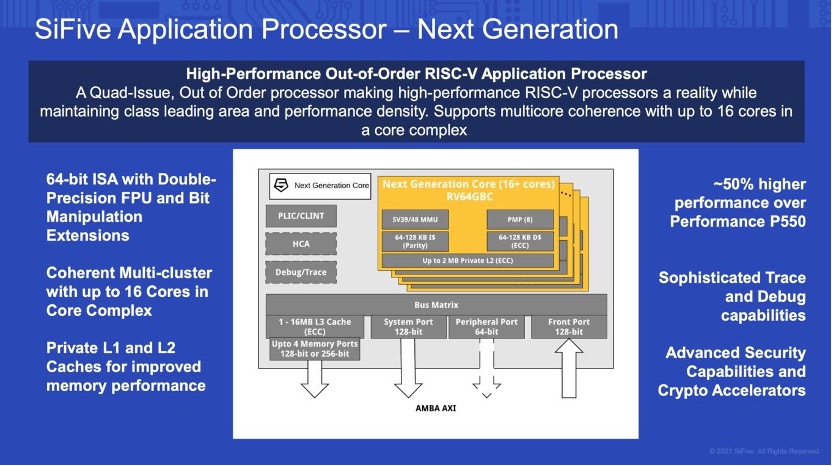The battle between x86 and Arm for high-performance has just started, and RISC-V is inserted horizontally
x86 and Arm RISC-V
After Apple launched the M1 Pro and M1 Max processors, the market seems to have once again sounded the clarion call for the battle between x86 and Arm. The argument that "Arm can only work on the mobile terminal" seems to be increasingly untenable. Apple's path of "de-Intelization" has also become more and more determined. The only Intel product Apple currently sells is the workstation-level Mac Pro. After the two-year transition period is completed, Apple may be really ready to enter the desktop chip. When the two fought inextricably, RISC-V was not to be outdone, looking for opportunities to participate in the war.
Up to 128 cores, comparable to A78
In June of this year, SiFive released the P550, a high-performance RISC-V core, and declared it to be one of the fastest RISC-V processors. Evolved from the U84 micro-architecture, this out-of-sequence RISC-V core with a three-launch 13-stage pipeline has undergone benchmark tests of SPECint2006 and SPECfp2006.

P550 and Cortex-A75 performance comparison / SiFive
From the results, we can see that P550 is already a bit higher than Arm's Cortex-A75, and its performance per unit area is three times that of Cortex-A75. SiFive announced that the core will be used in Intel's first 7nm product Horse Creek. It will finally be available in 2022. However, considering that Intel has postponed the 7nm process Intel 4 to 2023, Horse Creek is also likely to be delayed as well. Although the P550 has only been released soon, SiFive seems to be ready for the next higher performance RISC-V core.
In recent industry conferences, SiFive announced the successor to P550. Although this high-performance core has not yet been named, SiFive has given many performance parameters. This is a 4 launch out of order. The core's instruction and data first level cache has been increased from P550's 32kb to 64-128kB, the second level cache has been increased from 256kB to 2MB, the third level cache has been expanded from 4MB to 16MB, and a maximum of 4 is supported. A 256-bit memory port.

Next-generation RISC-V application processor / SiFive
In addition to the cache, the maximum frequency of the core has also been increased from 2.4GHz of the P550 to 3.5GHz. In the P550, a Core Complex contains up to 4 cores, and a Core Complex in the next-generation cores can contain up to 16 cores, and 128 cores can be achieved under the highest specifications.
Compared with P550, the performance of this core has been improved by about 50%. exist. So how does it compare to the x86 and Arm lineups? SiFive revealed that compared with the Intel Rocket Lake released in March this year and the Arm Cortex-A78 released last year, the single-core performance of this core is almost the same, but SiFive did not specify the comparison index or test benchmark. In SiFive's view, this CPU core can already be used in PCs and servers, and small-scale designs can also be used in mobile and embedded devices. However, SiFive will only provide the core RTL until 2022 for developers to run on the FPGA and start the development of prototype software.
Beyond x86, Arm can be expected
In fact, whether it is SiFive or Alibaba's flat-headed brother, they will compare the previous generations of Arm cores when they release their high-performance RISC-V cores. It can be said that the Xuantie 910 of Pingtou was released at the same time. It was named the highest performance RISC-V core. At that time, it was directly against the Cortex A73 core of Arm. The P550 targets Arm's Cortex-A75, and the next generation directly refers to the Cortex-A78. Each generation is slowly narrowing the distance between RISC-V and Arm.
However, after so many years of development, Arm and x86 have not yet reached the limit in terms of scalability. Under Intel's leadership that truly focuses on the chip itself rather than profit, both Alder Lake and Raptor Lake will enjoy the double dividend of the new process and the new architecture. Arm will also offer the first cores based on Armv9 next year. Both Cortex-A710 and Cortex-X2 have improved performance and power consumption by more than 10%. If the RISC-V core wants to catch up across generations, it can only provide a performance improvement of more than 50% like SiFive.


